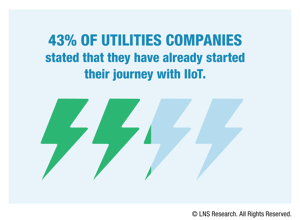The #MondayMusings Industrial Transformation blog series provides insight and analysis for executives from recent briefings, events, and publications @LNSResearch.
Click here to speak to Matt Littlefield
The Power Generation Industry is Unwittingly Becoming a Digital First Mover
Last month I had the opportunity to attend Asia Power Week with Susan Peterson Sturm, Digital Lead of Power Generation & Water at ABB, where we presented new research on how to build a Digital Transformation roadmap. The event was a real eye-opener. Many industry outsiders don't realize the degree to which the power generation industry is embracing transformation today. They see the industry as slow-moving and hampered by regulatory, social, and structural factors that stifle innovation.
 Despite these issues, the industry at large has become one of the fastest moving when it comes to embracing Digital Transformation. "Why?" you may wonder. I believe it is because industry leaders aren't chasing digital hype. Rather, they see Industrial Transformation as a foregone conclusion and immediate in timing, with digital not as the goal but the enabler.
Despite these issues, the industry at large has become one of the fastest moving when it comes to embracing Digital Transformation. "Why?" you may wonder. I believe it is because industry leaders aren't chasing digital hype. Rather, they see Industrial Transformation as a foregone conclusion and immediate in timing, with digital not as the goal but the enabler.
So, what is the conclusion? It is the multiple challenges that the industry is facing, the most well-known of which is the accelerating shift from centralized base load power generation to distributed intermittent renewable energy (wind and solar). The shift turns the traditional operating model of generation assets on its head. The result is a dramatic impact on the need for flexibility and agility in operating assets. It also means that visibility across the vertically-integrated value chain is more important than ever before.
During the many conversations and presentations at the event, it became clear that these changes are universal across the industry and that the response is nearly universal as well:
 Implement an Asset Performance Management (APM) framework for risk-based maintenance, operation, and optimization of assets
Implement an Asset Performance Management (APM) framework for risk-based maintenance, operation, and optimization of assets
- Use Big Data analytics to improve situational awareness and operational intelligence for enhanced decision support
ABB Going Digital
ABB is not a company new to the software space. It's roots in software and digital go back over 35 years as an early pioneer in Distributed Control Systems (DCS) and process automation. Over the years, ABB built a substantial automation business and is the market share leader for power generation.
More recently, the company's enterprise software business (part of its power grids division) was built partly out of multiple high-profile acquisitions including Ventyx (2010) and then Mincom (2013), among others. Behind the scenes, we're sure the growth included a concerted effort on the part of IT and operations to collaborate toward an effective operations technology (OT) ecosystem. However, IT-OT convergence isn't easy. Not for industrial companies or industrial suppliers; to date, ABB Enterprise Software has faced a number of challenges living up to initial expectations.
Fast forward to 2016 when ABB hit the refresh button and launched the next phase of its digital strategy. ABB’s new Chief Digital Officer is Guido Jouret (formerly of Cisco, Nokia) who aligned a new team of digital leaders, now embedded across the company's various divisions and business units. The main first offering of the new digital team was ABB Ability™, launched earlier this year and separate from the existing enterprise software business and other software assets distributed across the company. ABB Ability is a cloud-based platform. In partnership with Microsoft and IBM, ABB plans for it to enable interoperability, Big Data analytics, and edge connectivity for next-gen applications and 180 of ABB’s existing software solutions.
The digital leaders across ABB have the responsibility to work with the businesses they are now a part of to build new industry-focused digital solutions and go-to-market strategies. At Asia Power Week, ABB made it clear that it believes Digital Transformation is not a big bang technology implementation project. Instead, in the phase, it's a transformational journey that should start small, with clearly defined problem statements and use cases that a company can solve quickly, iterate on, and use to drive scalable future success.
LNS Research Take
Right now, ABB is saying and doing all the right things where digital is concerned. As LNS Research has repeatedly said over the past several months, the industry has moved beyond digital hype and wants to solve bona fide business problems. Long-term digital success at ABB and for the company's customers will be dictated by:
- Culture change: transformation is messy. There will be internal winners and losers as there is with any change; a positive cultural vision for the future is essential to prevail over those that try to thwart change. For industrial companies, it means effective change management for organizational structure, operating paradigms, collaboration models, decision-making rights, and more. For industrial solution providers, it means effective change management for product management, marketing, client engagement, partner ecosystems, and value delivery.
- Reduce platform friction: the industry is quickly learning that leading with a platform message does not resonate with customers. ABB Ability is appropriately leading with interoperable applications and analytics. However, this new positioning does not diminish the importance of having a solid platform to quickly and cost-effectively enable mash-up applications and analytics. If ABB Ability can't easily and cost-effectively enable desired user experiences, it will quickly end up in the IoT platform graveyard.
- Create end-to-end solutions: digital solutions that recreate the silos of old across traditional functions and supply chain nodes defeat the purpose. That's not to say that there must be one platform for all use cases — but platform interoperability is critical. For industrial companies in the power generation industry, that means using an interoperable toolset across power generation, transmission, and distribution to enable solutions like APM. For industrial solution providers, it means the same. In both cases, it might mean effective collaboration across distinct business units, divisions, or even companies.